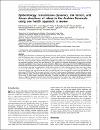| المؤلف | Islam, Md Mazharul |
| المؤلف | Naeem, Aisha |
| المؤلف | Mshelbwala, Philip P. |
| المؤلف | Dutta, Pronesh |
| المؤلف | Hassan, Mohammad Mahmudul |
| المؤلف | K. Elfadl, Ahmed |
| المؤلف | Kodama, Chiori |
| المؤلف | Zughaier, Susu M. |
| المؤلف | Farag, Elmoubashar |
| المؤلف | Bansal, Devendra |
| تاريخ الإتاحة | 2025-03-03T07:10:07Z |
| تاريخ النشر | 2025 |
| اسم المنشور | European Journal of Public Health |
| المصدر | Scopus |
| المعرّف | http://dx.doi.org/10.1093/eurpub/ckae164 |
| الرقم المعياري الدولي للكتاب | 11011262 |
| معرّف المصادر الموحد | http://hdl.handle.net/10576/63417 |
| الملخص | Despite global initiatives to eliminate dog-mediated human rabies by 2030, the Arabian Peninsula faces challenges due to insufficient data. This review addresses the current rabies situation and knowledge gaps in the region and proposes One Health interventions. Employing a mixed-method approach combining scoping and systematic review, the study commenced with a Delphi discussion to identify knowledge gaps and set objectives. The literature search encompassed published articles and grey literature. The spatial and temporal distribution of rabies was analysed, alongside quantitative meta-analyses to assess prevalence. Rabies virus gene sequences from the NCBI database were examined for reservoir hosts and evolutionary patterns. The final Delphi discussion with experts focused on addressing knowledge gaps and formulating One Health interventions. The first reported human rabies case in this region occurred in Saudi Arabia in 1980. Yemen reported the highest number of cases (439), followed by Iraq (249), Saudi Arabia (91), Jordan (14), and Oman (9). Fox bites accounted for the most cases (47.4%), followed by dog (36.8%) and wild animal (15.8%) bites. The virus was detected in at least 21 animal species. Phylogenetic analysis detected a single strain with two clades, with foxes being the primary virus reservoir. However, the experts expressed scepticism about the accuracy of rabies reports in scientific literature. To achieve the 2030 goal of eliminating dog-mediated human rabies, a stepwise approach towards rabies elimination assessment is crucial in the region. Enhanced surveillance, awareness campaigns, and access to post exposure prophylaxis are essential to address the disease burden. |
| اللغة | en |
| الناشر | Oxford University Press |
| العنوان | Epidemiology, transmission dynamics, risk factors, and future directions of rabies in the Arabian Peninsula using one health approach: a review |
| النوع | Article |
| الصفحات | i14-i22 |
| رقم العدد | Supplement_1 |
| رقم المجلد | 35 |
|
dc.accessType
| Open Access |


